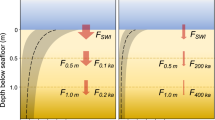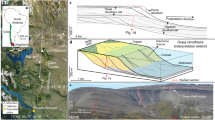Abstract
The deposition and long-term burial of organic carbon in marine sediments has played a key role in controlling atmospheric O2 and CO2 concentrations over the past 500 million years1. Marine carbon burial represents the dominant natural mechanism of long-term organic carbon sequestration1,2. Fjords—deep, glacially carved estuaries at high latitudes—have been hypothesized to be hotspots of organic carbon burial, because they receive high rates of organic material fluxes from the watershed3. Here we compile organic carbon concentrations from 573 fjord surface sediment samples and 124 sediment cores from nearly all fjord systems globally. We use sediment organic carbon content and sediment delivery rates to calculate rates of organic carbon burial in fjord systems across the globe. We estimate that about 18 Mt of organic carbon are buried in fjord sediments each year, equivalent to 11% of annual marine carbon burial globally4. Per unit area, fjord organic carbon burial rates are one hundred times as large as the global ocean average, and fjord sediments contain twice as much organic carbon as biogenous sediments underlying the upwelling regions of the ocean1. We conclude that fjords may play an important role in climate regulation on glacial–interglacial timescales.
This is a preview of subscription content, access via your institution
Access options
Subscribe to this journal
Receive 12 print issues and online access
$259.00 per year
only $21.58 per issue
Buy this article
- Purchase on Springer Link
- Instant access to full article PDF
Prices may be subject to local taxes which are calculated during checkout


Similar content being viewed by others
Change history
22 May 2015
In the version of this Letter originally published, the stated rates of organic carbon burial for fjords were incorrect in the penultimate sentence of the abstract, it should have read: 'Per unit area, fjord organic carbon burial rates are one hundred times as large as the global ocean average, and fjord sediments contain twice as much organic carbon as biogenous sediments underlying the upwelling regions of the ocean1.' This error has been corrected in all versions of the Letter.
References
Berner, R. A. Burial of organic carbon and pyrite sulfur in the modern ocean: Its geochemical and environmental significance. Am. J. Sci. 282, 451–473 (1982).
Hedges, J. I., Keil, R. G. & Benner, R. What happens to terrestrial organic matter in the ocean? Org. Geochem. 27, 195–212 (1997).
Nuwer, J. M. & Keil, R. G. Sedimentary organic matter geochemistry of Clayoquot Sound, Vancouver Island, British Columbia. Limnol. Oceanogr. 50, 1119–1128 (2005).
Hedges, J. I. & Keil, R. G. Sedimentary organic-matter preservation—an assessment and speculative synthesis. Mar. Chem. 49, 81–115 (1995).
Burdige, D. J. Burial of terrestrial organic matter in marine sediments: A re-assessment. Glob. Biogeochem. Cycles 19, GB4011 (2005).
Hedges, J. I. Global biogeochemical cycles: Progress and problems. Mar. Chem. 39, 67–93 (1992).
Blair, N. E. & Aller, R. C. The fate of terrestrial organic carbon in the marine environment. Ann. Rev. Mar. Sci. 4, 401–423 (2012).
Gershanovich, D. E., Gorskova, T. I. & Konyukov, A. I. Organic Matter of Modern and Ancient Sediments and Methods if its Investigation (in Russian) (Nauka, 1974).
Durr, H. H. et al. Worldwide typology of nearshore coastal systems: Defining the estuarine filter of river inputs to the oceans. Estuar. Coast. 34, 441–458 (2011).
Sepulveda, J., Pantoja, S. & Hughen, K. A. Sources and distribution of organic matter in northern Patagonia fjords, Chile ( 44–46° S): A multi-tracer approach for carbon cycling. Cont. Shelf. Res. 31, 315–329 (2011).
Bianchi, T. S. Biogeochemistry of Estuaries (Oxford Univ. Press, 2006).
Syvitski, J. P. M., Burrell, D. C. & Skei, J. M. Fjords; Processes and Products (Springer, 1987).
Louchouarn, P., Lucotte, M., Canuel, R., Gagne, J-P. & Richard, L-F. Sources and early diagenesis of lignin and bulk organic matter in the sediments of the Lower St. Lawrence Estuary and the Saguenay Fjord. Mar. Chem. 58, 3–26 (1997).
St-Onge, G. & Hillarie-Marcel, C. Isotopic constraints of sedimentary inputs and organic carbon burial rates in the Saguenay Fjord, Quebec. Mar. Geol. 176, 1–22 (2001).
Galy, V., Beyssac, O., France-Lanord, C. & Eglinton, T. Himalayan erosion: A geological stabilization of carbon in the crust. Science 322, 943–945 (2008).
Hilton, R. G., Galy, A., Hovius, N. & Horng, M. J. Efficient transport of fossil organic carbon to the ocean by steep mountain rivers: An orogenic carbon sequestration mechanism. Geology 39, 71–74 (2011).
Hovius, N., Stark, C. P. & Allen, A. Sediment flux from a mountain belt derived by landslide mapping. Geology 25, 231–234 (1997).
Hilton, R. G., Galy, H., Hovius, N., Horng, M-J. & Chen, H. Efficient transport of fossil organic carbon to the ocean by steep mountain rivers: An orogenic carbon sequestration mechanism. Geology 39, 71–74 (2010).
McLeod, R. J. & Wing, S. R. Strong pathways for incorporation of terrestrially derived organic matter into benthic communities. Estuar. Coast. Shelf Sci. 82, 645–654 (2009).
Hilton, R. G., Galy, A. & Hovius, N. Riverine particulate organic carbon from an active mountain belt: Importance of landslides. Glob. Biogeochem. Cycles 22, GB1017 (2008).
Hilton, R. G., Galy, A., Hovius, N. & Horng, M. J. Efficient transport of fossil organic carbon to the ocean by steep mountain rivers: An orogenic carbon sequestration mechanism. Geology 39, 71–74 (2011).
Waterson, E. J. & Canuel, E. A. Sources of sedimentary organic matter in the Mississippi River and adjacent Gulf of Mexico as revealed by lipid biomarker and δ13CTOC analyses. Org. Geochem. 39, 422–439 (2008).
Yool, A. & Fasham, M. J. R. An examination of the “continental shelf pump” in an open ocean general circulation model. Glob. Biogeochem. Cycles 15, 831–844 (2001).
Sigman, D. M. & Boyle, E. A. Glacial/interglacial variations in atmospheric carbon dioxide. Nature 407, 859–869 (2000).
Zeng, N. Glacial-interglacial atmospheric CO2 change—the glacial burial hypothesis. Adv. Atmos. Sci. 20, 677–693 (2003).
Zeng, N. Quasi-100ky glacial–interglacial cycles triggered by subglacial burial carbon release. Clim. Past Discuss. 2, 371–397 (2006).
Gilbert, R., Nielsen, N., Moller, H., Desloges, J. R. & Rasch, M. Glacimarine sedimentation in Kangerdluk (Disko Fjord), West Greenland, in response to a surging glacier. Mar. Geol. 191, 1–18 (2002).
Kulinski, K., Kedra, M., Legezynska, J., Gluchowska, M. & Saborska, A. Particulate organic matter sinks and sources in high Arctic fjord. J. Mar. Syst. 139, 27–37 (2014).
Powell, R. D. in Glacial-Marine Sedimentation (ed. Molnia, B. F.) (Plenum Press, 1983).
Kilian, R. et al. Late Pleistocene to Holocene marine transgression and thermohaline control on sediment transport in the western Magellanes fjord system of Chile (53° S). Quat. Int. 161, 90–107 (2007).
Acknowledgements
We thank P. Louchouarn, P. Santschi, F. Marcantonio and S. Woodard for their reviews of the original manuscript. We also thank the University of Otago for a grant to C. Savage that funded the research cruise, and the crew of the RV Polaris II for sampling assistance. V.G. was supported by the US National Science Foundation (Grant OCE-0928582). Finally, we thank University of Otago scientists C. D. Rundgren, for field assistance and identification of vegetation samples, and S. E. Schuller, for field assistance and providing Supplementary Fig. 1.
Author information
Authors and Affiliations
Contributions
R.W.S.—Sample collection, data analysis and interpretation, developed the global fjord and oceanic C burial models. T.S.B. —Authored funding proposal, project planning, sample collection, data analysis and interpretation. M.A.—Developed the core age model, performed radioisotope dating, calculated linear sedimentation rates via 210Pb analyses. Data interpretation. C.S.—Provided funds for shiptime aboard the RV Polaris II, and coordinated the research, site selection and sampling during the 2007 and 2010 cruises. Authored the proposal for the project. Data interpretation. V.G.—Provided AMS analyses and fossil organic carbon yield quantification techniques. Data interpretation.
Corresponding author
Ethics declarations
Competing interests
The authors declare no competing financial interests.
Supplementary information
Supplementary Information
Supplementary Information (PDF 2354 kb)
Rights and permissions
About this article
Cite this article
Smith, R., Bianchi, T., Allison, M. et al. High rates of organic carbon burial in fjord sediments globally. Nature Geosci 8, 450–453 (2015). https://doi.org/10.1038/ngeo2421
Received:
Accepted:
Published:
Issue Date:
DOI: https://doi.org/10.1038/ngeo2421
This article is cited by
-
Detailed monitoring reveals the nature of submarine turbidity currents
Nature Reviews Earth & Environment (2023)
-
Substantial role of check dams in sediment trapping and carbon sequestration on the Chinese Loess Plateau
Communications Earth & Environment (2023)
-
Large contributions of petrogenic and aged soil-derived organic carbon to Arctic fjord sediments in Svalbard
Scientific Reports (2023)
-
Fossil organic carbon utilization in marine Arctic fjord sediments by subsurface micro-organisms
Nature Geoscience (2023)
-
Rock organic carbon oxidation CO2 release offsets silicate weathering sink
Nature (2023)



